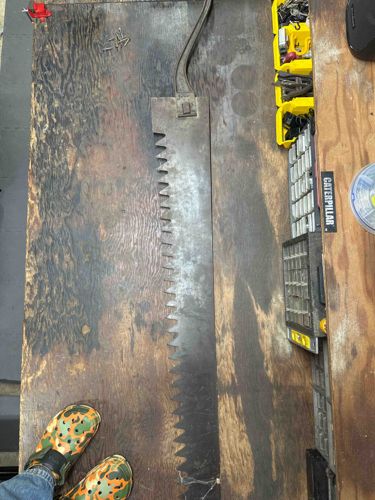
Two-Man Crosscut Saw
The item is a large, antique two-man crosscut saw, commonly used for felling trees or bucking logs. It features a long, rigid steel blade with aggressive, V-shaped teeth designed for cutting across the grain of wood. The blade appears to be quite long, likely several feet in length, and is characterized by a dark, aged patina suggesting significant use and exposure. One end of the saw shows a visible handle mechanism, likely a D-handle or 'tilting pad' handle, which is attached to the blade via a metal ferrule or socket. This handle appears to be made of metal, possibly steel, and has a curved or bent shape for ergonomics. The teeth of the saw exhibit wear consistent with its age and function, possibly showing some dulling or minor chips, though the overall structure appears intact. No specific manufacturer's marks or signatures are discernible from the image. The construction suggests a robust design typical of early to mid-20th-century logging tools. Its condition indicates it is a well-used piece, likely with surface rust and discoloration, but it retains its fundamental form. The quality of craftsmanship would have been focused on durability and cutting efficiency, essential for such a heavy-duty tool. The visible wear, scratches, and dark appearance contribute to its historical character.
AI-Generated Appraisal Disclaimer
Estimated Value
$100-175
Basic Information
Category
Hand Tool
Appraised On
November 30, 2025
Estimated Value
$100-175
Item Description
The item is a large, antique two-man crosscut saw, commonly used for felling trees or bucking logs. It features a long, rigid steel blade with aggressive, V-shaped teeth designed for cutting across the grain of wood. The blade appears to be quite long, likely several feet in length, and is characterized by a dark, aged patina suggesting significant use and exposure. One end of the saw shows a visible handle mechanism, likely a D-handle or 'tilting pad' handle, which is attached to the blade via a metal ferrule or socket. This handle appears to be made of metal, possibly steel, and has a curved or bent shape for ergonomics. The teeth of the saw exhibit wear consistent with its age and function, possibly showing some dulling or minor chips, though the overall structure appears intact. No specific manufacturer's marks or signatures are discernible from the image. The construction suggests a robust design typical of early to mid-20th-century logging tools. Its condition indicates it is a well-used piece, likely with surface rust and discoloration, but it retains its fundamental form. The quality of craftsmanship would have been focused on durability and cutting efficiency, essential for such a heavy-duty tool. The visible wear, scratches, and dark appearance contribute to its historical character.
Related Tags
Explore similar items and categories:
Get Your Items Appraised
Instant estimates of your treasures with AI-powered instant appraisals